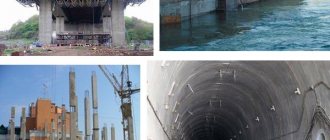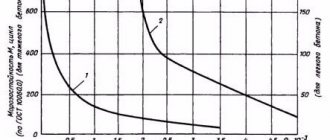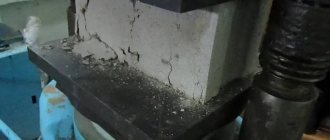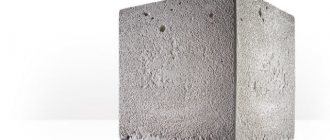This is one of the most important regulatory indicators of concrete in the construction industry, affecting the operational reliability and durability of products. It characterizes the ability of a hardened material, after repeated freezing and thawing, not to lose its strength characteristics by more than 5% for heavy concrete, and no more than 15% for cellular concrete.
As you know, to check technical indicators, control cubes of concrete mixture measuring 100 mm X 100 mm X 100 mm are poured. These samples are subjected to frost resistance tests after 28 days of hardening. It must be said that frost resistance can only be measured in laboratory conditions. Let's find out how the tests are carried out.
GOST 10060 – 2012 Concrete. Methods for determining frost resistance
The test cubes must be placed in aqueous or slightly alkaline solutions for a certain time.
Remove from the water or solution, allow to dry and place in the freezer. The temperature in the chamber is set to -18C and maintained for 3 hours.
Then the samples are placed in another chamber, in which the temperature is +20C and the samples are kept for 3 hours at this temperature.
Thus, one cycle of freezing and thawing is performed. If the design documentation specifies a concrete grade for frost resistance, which is designated F 100, for example, this means that laboratory samples of these concretes must withstand 100 cycles of alternating thawing and freezing and, after all tests, not lose more than 5% of the control samples in strength and weight .
Moreover, they should not have any visible damage to the surface, such as chips, cracks or peeling on the edges of the samples.
After carrying out the designed tests for frost resistance, the samples are subjected to a compression test.
Each batch contains 6 control and 12 test cubes. After checking the strength indicators, the results are processed using a combination of a number of formulas; we will not consider them in this article.
Let us only note once again that the tests are considered successful only if the deviation of the compression indicator of the tested cubes in the average statistical value does not exceed 5% of the strength of the control cubes.
What is the frost resistance of aerated concrete?
According to the certificate of conformity, issued on the basis of independent tests, the frost resistance of YTONG aerated concrete blocks of any density is F100. This is a very high figure for stone wall materials. How many years of operation is this? It's impossible to say for sure. As we have already noted, according to the specified SP***, the service life of masonry materials with a grade of only F35 is at least 100 years. The standard does not specify how long materials with a higher grade will last. It is believed that 100 years is quite enough for a building structure.
Photo: Pexels
Obviously, aerated concrete is much more durable, but tests that can determine its exact service life are simply not carried out: 100 years is a period that suits both manufacturers, designers, and buyers. In addition, laboratory tests for the F100 brand last about 4 months, and testing for a brand, for example, F200 is too long and expensive. Moreover, there will be no practical use from this information.
Aerated concrete walls are always finished on the outside, and if facing bricks or other materials that protect the walls from precipitation are used for this, the service life of the enclosing structure will increase, since it will not become waterlogged.
Concrete grades by frost resistance
Graduated F 25, F 35….. F 800, F 1000. A total of 13 classes.
It should be noted that the frost resistance grade does not indicate the number of winters that the concrete in these structures will withstand, not at all. After all, in winter the temperature crosses the zero line not just once, but many times. These quantities do not have such a direct relationship.
But where there is a dependence is in the strength indicators of concrete. The higher the grade of concrete, the higher the frost resistance should be. Here is the dependency table:
| Concrete grade | Concrete class | Frost resistance F |
| M100, M150 | V-7.5, V-12.5 | F50 |
| M200, M250 | V-15, V-20 | F100 |
| M300, M350 | V-22.5, V-25 | F200 |
| M400 | B-30 | F300 |
| M450, M550, M600 | V-35, V-40, V-45 | F200-F300 |
There are basic test methods, second and third. Their difference is in the solutions they contain. So, in the basic method, an aqueous solution. In the 2nd and 3rd – 5% sodium chloride solution.
But in the 3rd, an increased temperature of up to -55C is also used. These tests apply only to concrete road and airfield pavements.
Today there is a device called “Measuring complex for accelerated measurement of frost resistance of concrete Concrete - Frost”.
This device allows you to obtain a series of frost resistance indicators in a short time. The video below says nothing about the legality of applying these results. Therefore, it can be assumed that its results are used for self-testing in concrete plants.
Independent laboratories most likely do not use such devices in their practice, but are required to use the methods prescribed in GOST.
Application depending on brand
The lower the number indicated in the name, the less the material is able to withstand temperature changes. It follows that when building in regions with high and low temperatures, it is worth using brands with the highest number. For regions with milder climates, materials with low numbers are suitable. For example, for the central and western parts of Russia, F50-F150 brands are actively used. They cope well with our weather conditions, do not collapse or crack.
What affects the frost resistance of concrete?
Our native water-cement ratio. This is an indicator of the ratio of the mass of water to the mass of cement (W/C). The higher this indicator, the more water in the concrete mass will not react with the cement clinker.
Of course, it will evaporate over time, but the remaining excess water will have a negative effect.
As you know, when water freezes, it expands in volume, turning into ice. The expansion coefficient is 1.09.
Thus, increasing in volume by 9%, water puts pressure on the concrete from the inside and destroys it, which naturally reduces frost resistance.
Water absorption
Paradoxical as it may seem, concrete in the design strength indicator, when in contact with water, absorbs water in addition to the water already present inside, which has not reacted with the cement clinker. The surface layers will take up water especially actively. The absorbed water is subject to the effect of the thermal expansion process already described above. And as a result - a drop in the frost resistance grade.
Porosity of concrete
There is a theory that small pores filled with air dampen the pressure of ice crystals formed as a result of freezing and thereby reduce the loss of the destructive effect. This theory has been confirmed in practice.
Porosity of aggregates
If the filler has a porous macrostructure, then again, as in the well-known effect, water accumulates and it freezes and causes expansion of the concrete structure and, as a result, a decrease in frost resistance. When using dolomite aggregates or crushed limestone rocks, it is almost impossible to achieve a high frost resistance.
Concrete grade
Yes, it is the strength indicators, in other words, the brand of cement used that significantly affects the final frost resistance. And as you know, the grade of concrete is directly related to the W/C (see point 1).
Steaming concrete and reinforced concrete structures. During this process, fine-porous structures are destroyed and relatively large capillaries are formed, which, as is generally accepted, do not contribute to increasing frost resistance.
Frost resistance of facing bricks.
We recommend that you immediately stop using bricks with frost resistance F35. Practice shows that it is suitable only for regions with a mild, dry and warm climate, of which there are very few in Russia. There have been precedents when even a brick with the required minimum F50 cracked in the sixth year of operation. This often happens with bricks with a lot of lime (you can read more about lime and the composition of clays in our other articles). The F75 brick performs very well in real conditions. It is produced in Russia at LSR, Golitsyn Brick Factory; these manufacturers successfully combine decent quality with a reasonable price. It is absolutely good to use brick F100 and higher. This is a German clinker brick.
In fact, its frost resistance is even higher, but the European “GOST” requires testing only for 100 cycles. Clinker will delight you not only with its high frost resistance, but also with its unsurpassed strength and low water absorption, and most importantly, with its beautiful appearance.
How to increase the frost resistance of concrete
The minds of many scientists today are occupied with this super task. It is considered an important indicator that has a great influence on frost resistance not only the overall porosity of the cement stone, but also the size of these pores.
Scientists through research have come to the conclusion that micropores even help increase frost resistance, because water at a temperature of 0 -1 C begins to turn into ice and expands without disturbing the structure of the cement stone in these pores. Micropores seem to dampen the stretching effect.
What tricks do builders resort to in pursuit of high frost resistance:
Reduced water-cement ratio
The optimal W/C is considered to be 0.4 -0.5; at this ratio, the formation of a capillary structure of cement stone does not occur.
Of course, it is completely impossible to avoid porosity, but it is believed that these small pores are filled with water in a gel state, i.e. pseudo-hard, and are not subject to the expansion effect when moving to sub-zero temperatures.
Gel formations are formed before the onset of frost, therefore, the longer the hardening period of the cement stone before the appearance of sub-zero temperatures, the higher the frost resistance of concrete.
Application of plasticizing additives
Such as SSB (sulfite-alcohol stillage), SDB (sulfite-yeast brew), S-3. These plasticizers make it possible to increase the workability of the concrete mixture and, therefore, make it possible to increase the W/C to a value of 0.4-0.45, which, as we have already noted, has a positive effect on increasing frost resistance.
Application of air-entraining additives
As we have already discussed, the fine porosity of concrete stone increases frost resistance, which is why additives of this kind are used.
These additives can be petroleum products, vegetable fats, soap and many others. The dosages of these additives are related to the weight of the cement and they are very small up to 0.02%.
Introduction of organosilicon compounds into concrete mixtures
These are polyhydroxyloxanes and sodium silicates (GKZh-94, GKZh-13, GKZh-10). A chemical reaction occurs between these substances and the cement hydration products with the release of hydrogen and new complex formations.
They are insoluble in water and fill the capillary structures and pores of cement stone, thereby hydrophobizing the surfaces of concrete structures.
The hydrophobization process increases the water resistance of concrete, thereby improving frost resistance. The amount of additives is 0.1-0.2% by weight of cement.
How to choose the right bricks for construction
Brick is presented in a wide range, which means that before choosing one or another type, you must clearly understand for what purpose you want to purchase it.
Attention: When choosing a brick for building a house, you must study the climate of the country or city in which you live. You also need to take into account the resistance of the brick to low temperatures, because this is the most important point.
- If you do not have experience in selecting and purchasing bricks, then you should seek help from specialists who will allow you to choose exactly those building material options that are perfect for the construction of a particular object.
- For example, when purchasing building bricks, you need to remember that the minimum recommended by experts should be F35 according to GOST, and as for facing bricks, F50.
- If this is a load-bearing wall, then you should not make it from hollow material. It is better to make the inside part solid and the lining hollow.
- If this is a partition, then a hollow option is quite suitable for heated rooms. In this case, sound insulation will also increase. If the room is not heated, then it is better to use a solid version.
How to increase frost resistance
Often many people want to know what increases frost resistance. This is especially of concern to those who want to establish their production. In fact, it depends on many factors and you need to go through them in detail and in detail.
- First of all, this concerns the manufacturing technology itself, if you have special equipment, then special additives follow, they, in turn, begin to reduce the crystallization temperature of the liquid.
As you probably understood, this seriously increases the frost resistance of the product, so be sure to take this into account.
- It is also impossible not to take into account the raw materials that will be used, for example, the higher the percentage of quartz, the naturally higher the “F” index will be.
- If the material has a huge amount of calcium silicates, then the frost resistance of the finished product also increases.
Briefly about the main thing
- The frost resistance of concrete structures directly affects their durability, especially hydraulic, road, and irrigation structures.
- The processes of alternating freezing and thawing lead to the expansion of water in the concrete mass and, when turning into ice, an increase in volume by approximately 10%. This effect breaks the walls of capillaries and pores of cement stone and aggregates and reduces the strength of the structure.
- To avoid lengthy and expensive procedures for testing concrete samples for frost resistance, complexes of instruments from the Interpribor company are used, which make it possible to quickly determine frost resistance in accordance with GOST 10060-2012.
- In order not to worry about obtaining the necessary frost resistance, take a concrete mixture of a higher grade and this will certainly lead to its increase.
- Concrete mixtures based on dense aggregates, for example, granite crushed stone, will certainly have increased frost resistance.
- To pour concrete in cold weather, use antifreeze additives that prevent the water in the mixture from crystallizing and turning into ice. Being in a liquid state, water participates in the hydration reaction of cement and strength gains occur during frost. There are additives that allow you to work at -30C. But then it is necessary to add additives that accelerate the hardening of cement.
Determination of frost resistance and selection rules
In brick, frost resistance cycles are determined by freezing the material and then thawing it. The number of these procedures determines this parameter. Ceramic brick frost resistance is designated: F25; F35; F50; F75; F100; F200; F300.
Attention: This parameter also depends on the type of brick. Ceramic brick M50 will correspond to F25. But if you take silicate material of the same brand, then the frost resistance will be equal to F35. You should not think that the higher the frost resistance, the better it will be in your case.
Here we look at the following:
Face masonry
As a rule, the frost resistance of facing bricks is higher than that of ordinary material. For facade work, it is worth using a material of at least F35. For partitions that are in a heated room, this figure and a lower one can be used.
By type of design
The frost resistance of red brick is much higher than that of silicate brick. But the thickness of the wall is also important here. If you use ceramic bricks for masonry, then in terms of heat capacity, masonry of one brick will be approximately equal to the thickness of silicate material of two bricks.











